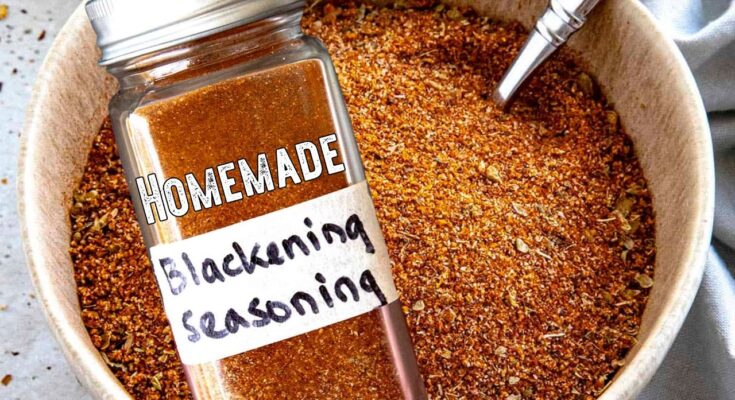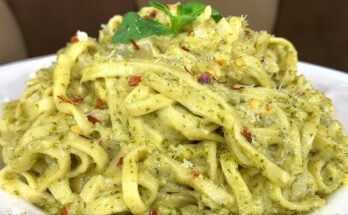Blackening Spice Recipe: Ever wondered what gives that delicious crust to blackened chicken or fish? That deep, smoky, slightly spicy coating that makes your tastebuds sing? That’s the magic of blackening spice—a bold blend of herbs and spices used to coat proteins before searing them at high heat. And while store-bought versions exist, nothing beats the freshness, flavor, and flexibility of making your own.
Making blackening spice at home allows you to tweak the flavor to your liking—whether you want it smoky, herby, super spicy, or low-sodium. It’s the kind of pantry staple that once you make it, you’ll wonder why you ever bought pre-made seasoning again.
In this guide, we’ll walk you through every step, from listing out the exact ingredients to mixing and storing, and even how to use it to turn your meals into flavor bombs. Whether you’re a seasoned cook or a curious beginner, you’re going to love how easy and rewarding this is.
Benefits of Homemade Blackening Spice
Creating your own blackening spice mix at home is more than just a fun kitchen experiment—it’s a smart and flavorful move that can level up your cooking game big time. Let’s break down why you’ll never want to go back to the store-bought stuff again.
1. Healthier Alternative
When you make your spice blend from scratch, you’re in control. Many pre-packaged seasoning blends contain excess sodium, preservatives, or even sugar—none of which you need when flavor is your goal. Making it yourself means you avoid unnecessary fillers and allergens.
2. Cost-Effective
Buying individual spices may seem pricey upfront, but one jar of each can make dozens of batches. Over time, homemade blends are significantly cheaper than buying small, pre-mixed bottles at the store.
3. Customizable
Love the smoky hit of paprika? Add more. Sensitive to heat? Tone down the cayenne. Prefer less salt? Skip it altogether. Homemade blackening seasoning is a flavor playground, and you’re the chef.
4. Fresher Flavor
Spices lose their flavor over time, especially when pre-blended. By mixing your own, you ensure peak flavor every single time—especially if you’re using freshly ground spices.
So yes, your homemade blackening spice isn’t just about taste—it’s about smart, healthy cooking that doesn’t cut corners.
What Does “Blackening” Mean in Cooking?
Before we dive into mixing, let’s take a quick culinary history trip. Blackening is a cooking technique that became famous thanks to Chef Paul Prudhomme, a legendary figure in Cajun and Creole cuisine. The process involves coating food in a spice blend and cooking it at high heat, usually in a cast-iron skillet, until the spices form a dark, flavorful crust.
Despite the name, blackening doesn’t mean burning. It’s a fine line—the spices char slightly but the food inside remains juicy and tender. The blackened crust comes from the milk solids in butter reacting with the spice mix and searing to perfection.
It’s bold. It’s smoky. It’s rich. And it’s oh-so satisfying when done right.
List of Ingredients You’ll Need
Here’s your shopping list for a classic blackening spice blend. These pantry staples combine to create a smoky, spicy, and slightly herby mix:
Core Ingredients:
- 2 tablespoons smoked paprika
- 1 tablespoon onion powder
- 1 tablespoon garlic powder
- 1 tablespoon dried oregano
- 1 tablespoon dried thyme
- 1 teaspoon cayenne pepper (adjust to heat preference)
- 1 teaspoon freshly ground black pepper
- 1 teaspoon salt (optional or to taste)
- ½ teaspoon white pepper (optional but adds depth)
You can find these at any grocery store, but for the freshest flavor, try sourcing from spice shops or online retailers that specialize in small-batch or organic spices.
Tools & Equipment Needed
Mixing up your blackening spice is super simple—you don’t need fancy kitchen gadgets. Here’s what you’ll need:
- Small mixing bowl – to combine everything
- Measuring spoons – accuracy matters here
- Whisk or spoon – for mixing
- Glass jar or airtight container – for storage
- Label – don’t forget to date it
Optional: Spice grinder or mortar and pestle if you’re grinding whole spices for max flavor.
Step-by-Step Guide to Making Blackening Spice
Making your own seasoning blend might just become your new favorite kitchen ritual. Here’s how to do it in three simple steps:
Step 1: Measure Your Ingredients
Accurate measurements are key. Use leveled spoons to scoop each spice and place them into your mixing bowl. If you’re adjusting for heat or salt, now’s the time to customize.
Step 2: Mix Thoroughly
Use a whisk or spoon to combine everything until the blend is evenly mixed. No clumps. No layers. Just a beautiful, balanced spice mix ready to shine.
Step 3: Store in an Airtight Container
Transfer your mix into a clean, dry glass jar with a tight-fitting lid. Label it with the name and date—you’ll thank yourself later.
Pro tip: Store in a cool, dark place. Your spice blend should stay fresh for up to 6 months.
Detailed Ingredient Profile
Every ingredient in a blackening spice mix plays a specific role. This isn’t just a “throw everything together” situation—each spice brings something unique to the table. Let’s break it down so you know exactly what’s going into your mix and why it matters.
Paprika: Adds Rich Color & Smoky Depth
Paprika is the heart of blackening spice. It gives the mix its signature reddish hue and adds a sweet, smoky base that ties all the flavors together. For best results, use smoked paprika—it delivers a deeper, more complex flavor compared to the regular kind. If you want a spicier kick, you can experiment with hot paprika.
Cayenne Pepper: Brings the Heat
This fiery little red powder is what gives blackening spice its bold, peppery edge. You don’t need a lot—just a teaspoon can bring serious heat. If you’re spice-sensitive, start small. For spice lovers, bump it up and feel the burn (in a good way).
Onion & Garlic Powder: Savory Aroma and Depth
These two create the savory foundation. Garlic powder gives it that rich, umami-like depth, while onion powder adds a touch of sweetness and body. They also help balance out the stronger herbs and spices.
Oregano & Thyme: Earthy and Herby
These dried herbs bring a Southern flair to the blend. Oregano adds a slight bitterness that helps cut through rich foods, while thyme brings a subtle, earthy aroma that elevates the entire mix.
Salt & Pepper: The Classic Balancers
Salt enhances all the other flavors, and black pepper adds its own mild heat and bite. You can adjust the salt based on your dietary needs—this recipe works great even with very little or no added salt.
White Pepper (Optional): A Mild Kick
White pepper isn’t always included, but it adds a mild, slightly floral spice that hits differently than black pepper. It’s subtle, but it rounds out the heat beautifully.
Pro Tips for Perfect Blackening Spice
Sure, mixing spices sounds easy—and it is—but these pro tips will take your seasoning to the next level. These are the tricks chefs use to make their spice blends stand out.
1. Toast Your Spices First (If Using Whole Spices)
Toasting whole spices before grinding them unlocks deeper, nuttier aromas. Simply heat a dry skillet over medium and toast the spices for 1-2 minutes until fragrant. Then grind them using a spice grinder or mortar and pestle.
2. Use Fresh Spices
Old spices lose flavor over time. If your paprika or oregano has been sitting in your pantry for years, it’s probably dull. Always check expiration dates, and whenever possible, buy small amounts from a spice store that moves a lot of stock.
3. Adjust the Heat
Not everyone loves fiery foods. If you’re sensitive to spice, reduce the cayenne or leave it out altogether. If you like it hotter, double it or even add a dash of chili powder or chipotle powder for smoky heat.
4. Mix in Small Batches
Spices lose potency over time. Mixing a big jar sounds convenient, but unless you use blackening spice often, stick to small batches. This way, your seasoning stays fresher, longer.
5. Label & Date Your Jar
It sounds simple, but labeling your jar avoids confusion later—especially if you have multiple homemade blends. Always include the date so you know when it’s time to refresh.
How to Use Blackening Spice
Okay, you’ve got your spice blend ready. Now what? This seasoning is super versatile—you can use it on meats, veggies, and even snacks. Here are some tasty ideas to get you started.
1. Blackened Chicken
Rub the spice mix generously over both sides of a chicken breast or thigh. Sear it in a hot cast-iron skillet with a little oil until it develops that famous blackened crust. Finish in the oven if needed.
2. Blackened Fish (Salmon, Tilapia, Catfish)
Seafood and blackening spice are a match made in heaven. Coat the fillets with the seasoning, sear them quickly in a buttered skillet, and serve with rice, grits, or salad.
3. Blackened Steak
Want that steakhouse vibe at home? Coat a ribeye or sirloin with the spice mix and pan-sear to create a bold, flavorful crust. Serve with mashed potatoes or charred veggies.
4. Vegetarian Uses
Don’t eat meat? No problem. Blackening spice adds serious flavor to:
- Tofu: Press it, slice it, season it, and pan-sear.
- Cauliflower steaks: A great plant-based dinner.
- Mushrooms: They soak up flavor like a sponge.
5. Snack It Up
Want a quick flavor boost?
- Sprinkle it on popcorn.
- Dust over roasted nuts.
- Add to sweet potato fries before baking.
Best Oils to Use with Blackening
Since blackening involves high heat, using the right oil is critical. Some oils smoke and burn quickly, which can ruin your dish and your kitchen vibe.
High Smoke Point Oils
Choose oils that can handle heat without breaking down:
- Avocado oil (520°F / 271°C)
- Grapeseed oil (420°F / 216°C)
- Canola oil (400°F / 204°C)
- Peanut oil (450°F / 232°C)
These oils stay stable at high temps, letting your seasoning caramelize instead of burn.
Butter vs. Oil Debate
Traditional blackening uses butter for richness and flavor, but it burns fast. A trick many chefs use: Mix butter and oil. The oil raises the smoke point while the butter adds that rich, nutty taste.
Cooking Methods for Blackening
Let’s get cooking! Here are the top three ways to cook with your blackening spice:
1. Pan-Searing (Classic Method)
This is the original technique made famous by Cajun chefs.
- Heat a cast-iron skillet until it’s screaming hot.
- Add oil (or oil + butter).
- Place seasoned meat/fish in the pan.
- Sear for 2–3 minutes per side.
It’s quick, bold, and gives that perfect crust.
2. Grilling
Love smoky flavor? Blackening spice shines on the grill. Preheat your grill, season your food, and cook over direct heat for that charred exterior and juicy inside.
3. Oven Roasting
For a hands-off approach, try the oven:
- Preheat to 425°F (220°C)
- Place seasoned meat or veggies on a sheet pan
- Roast until cooked through (timing depends on protein/veggie)
Great for batch cooking or meal prep.
Blackening Spice vs Cajun vs Creole
It’s easy to confuse blackening spice with Cajun or Creole seasonings—they share a lot of similar ingredients. But the differences matter, especially when you want the right flavor for a specific dish. Let’s break it down.
Blackening Spice
- Purpose-built for high-heat cooking.
- Usually has a higher ratio of paprika, garlic, and cayenne.
- Used to create that signature black crust on meats and fish.
- Focuses more on bold, smoky, spicy notes.
- Usually less salty than store-bought Cajun blends.
Cajun Seasoning
- Originates from the Louisiana bayou.
- Typically spicier and has a more aggressive punch.
- Often includes more black pepper and chili powder.
- Used in everything from stews to dry rubs.
- Often pre-salted.
Creole Seasoning
- Has more European influence (especially French and Spanish).
- Milder and more herb-forward—you’ll see more basil, thyme, and oregano.
- Used in sauces, gumbos, and lighter dishes.
- Less heat, more depth and balance.
So, Which One Should You Use?
- Want that charred crust? Go with blackening spice.
- Making a spicy gumbo or jambalaya? Cajun is your friend.
- Cooking something herbaceous and saucy? Creole’s your go-to.
Once you know the differences, you can even create hybrid blends for the perfect custom flavor.
Storage & Shelf Life
Storing your homemade blackening spice properly is just as important as making it right. Why? Because spices lose their potency over time—especially if they’re exposed to light, air, or moisture.
How Long Does It Last?
- Ideally, your blackening spice mix will stay fresh for 4 to 6 months.
- After that, it’s still safe to use, but the flavor might be weaker.
Storage Tips
- Use an airtight glass jar with a tight-fitting lid.
- Store it in a cool, dark pantry or cabinet—not next to your stove!
- Don’t use a wet spoon to scoop—it introduces moisture and can lead to clumping or mold.
How to Tell If It’s Still Good
- Smell it—if the aroma is faint or dull, it’s time to mix a new batch.
- Color matters too—faded spices are usually old spices.
- Do a taste test on your finger or a plain cracker to check for kick.
Bonus tip: Label the jar with the date you made it—it’s an easy way to track freshness.
Common Mistakes to Avoid
We’ve all been there—good intentions, but something goes wrong in the kitchen. Let’s make sure your blackening experience is a win from the start by avoiding these common mistakes.
1. Burning Instead of Blackening
This is the big one. The goal is a blackened crust, not a burned one.
- Don’t skip the oil or butter—it helps the spices stick and prevents scorching.
- Make sure your skillet is hot, but not smoking excessively.
- Keep an eye on the cook time—2–3 minutes per side is usually plenty.
2. Using the Wrong Pan
If you’re trying to blacken something in a nonstick pan, you’re missing out.
- Use a cast-iron skillet. It holds heat evenly and creates that crisp, seared crust.
- Stainless steel is okay, but doesn’t hold heat like cast iron.
3. Overseasoning
It’s easy to get carried away when you love bold flavor—but too much can overpower the dish.
- Use about 1 to 1½ teaspoons per serving of meat or fish.
- Rub it in evenly, but don’t cake it on like frosting.
4. Not Prepping the Protein
Whether it’s chicken, fish, or tofu, make sure it’s dry before seasoning. Pat it down with paper towels—excess moisture prevents a good sear.
5. Using Old Spices
We’ve said it before, but it’s worth repeating: fresh spices = better flavor. Old, faded paprika won’t give you the same smoky kick. Invest in quality spices and refresh your stock every few months.
FAQs about Blackening Spice Recipe
1. Can I make this spice mix salt-free?
Absolutely! Just skip the salt entirely, and you’ll still get tons of flavor from the herbs and spices. It’s a great option for low-sodium diets.
2. Is blackening spice really spicy?
It can be—but it doesn’t have to be. The cayenne pepper is what brings the heat. If you’re sensitive, reduce or omit it. Want it hotter? Add more or try a blend of cayenne and chipotle.
3. Can I double or triple the recipe?
Yes! Just scale the ingredient quantities evenly. Mix a big batch and store it in an airtight jar—it’ll last for months if stored properly.
4. Can I use this on the grill?
Definitely. Blackening spice is amazing on grilled meats and fish. Just coat the food well, then grill over direct heat to get that signature crust.
5. What can I use instead of cayenne pepper?
If you’re out of cayenne or want something milder, try chili powder for depth or smoked chipotle powder for a smoky twist. Paprika can also be increased slightly for more color without extra heat.
Conclusion
The best part? You now have complete control. Want it spicier? Go for it. Need a salt-free version? Done. You can adjust the blend to suit your taste, dietary needs, or whatever you’ve got in the pantry.
Plus, it’s fun. There’s something satisfying about mixing your own spices and knowing exactly what’s going into your food. It’s the kind of cooking confidence that comes from understanding not just the recipe, but the why behind every ingredient.
So grab those spices, mix up your blend, and get blackening. Your cast-iron skillet (and your tastebuds) will thank you.



